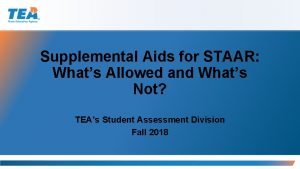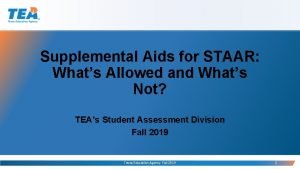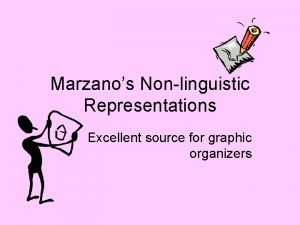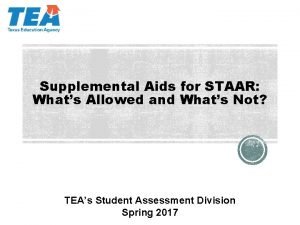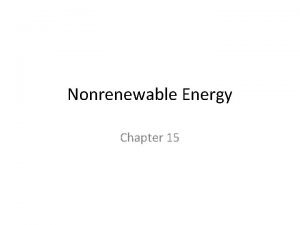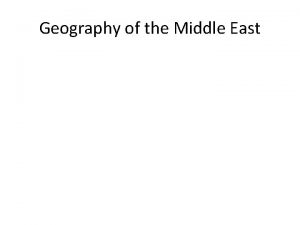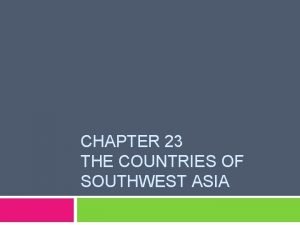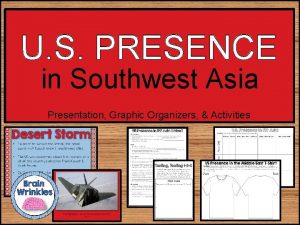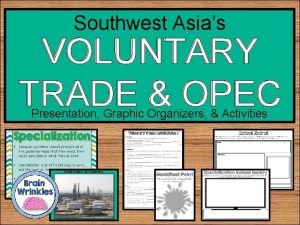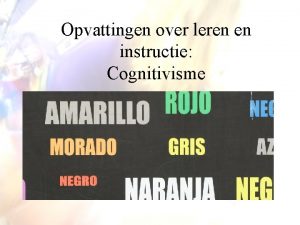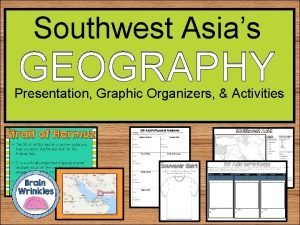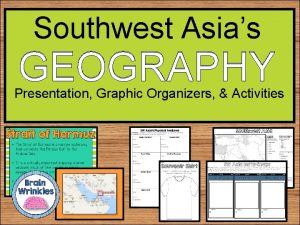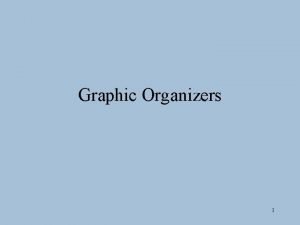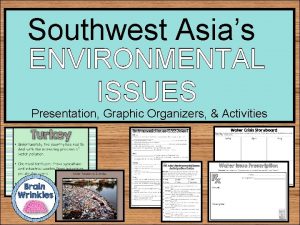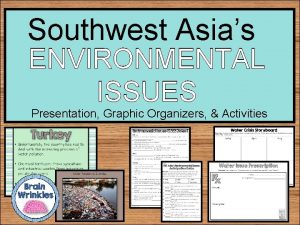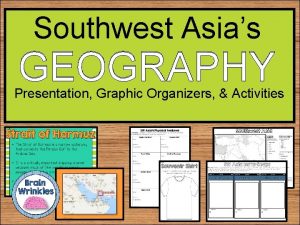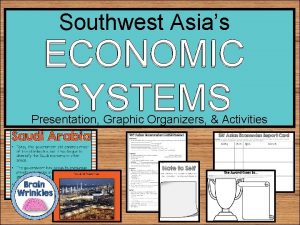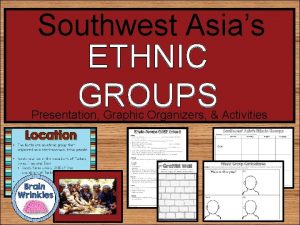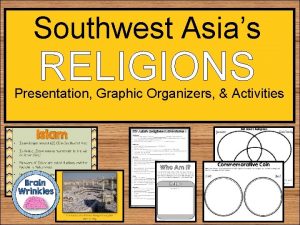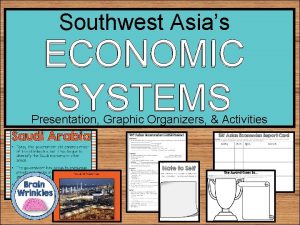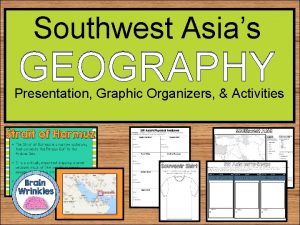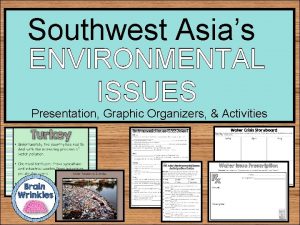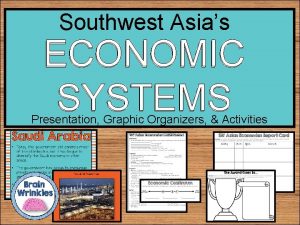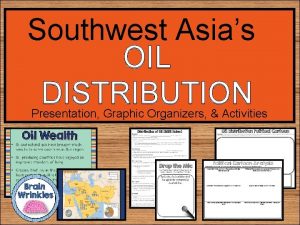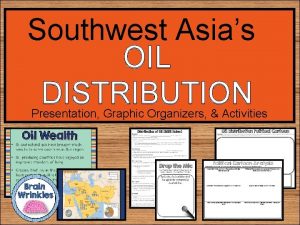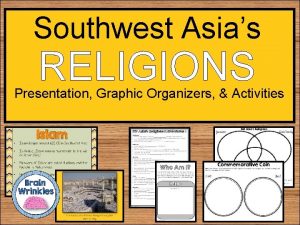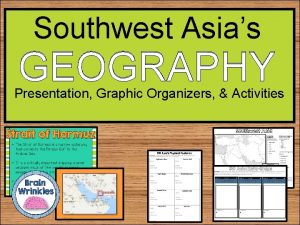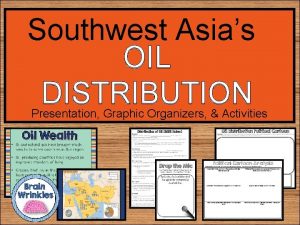Southwest Asias VOLUNTARY TRADE OPEC Presentation Graphic Organizers





























- Slides: 29

Southwest Asia’s VOLUNTARY TRADE & OPEC Presentation, Graphic Organizers, & Activities

STANDARDS: SS 7 E 5 Explain how voluntary trade benefits buyers and sellers in Southwest Asia (Middle East). a. Explain how specialization encourages trade between countries. b. Compare and contrast different types of trade barriers, such as tariffs, quotas, and embargoes. c. Explain why international trade requires a system for exchanging currencies between nations. d. Explain the primary function of the Organization of Petroleum Exporting Countries (OPEC). © Brain Wrinkles

Southwest Asia’s VOLUNTARY TRADE Ame Specialization, Trade Barriers, Currency Exchange, & OPEC © Brain Wrinkles

Specialization © Brain Wrinkles

Why Trade? • Voluntary trade occurs when different countries choose to engage in the exchange of goods with one another. • Countries trade goods because no country has all the resources necessary to produce every single thing its people need. • Voluntary trade is good for countries because it lets a country sell its own resources and buy the resources it needs. © Brain Wrinkles

Specialization • Because countries cannot produce all of the goods/services that they need, they must specialize in what they do best. • Specialization is an efficient way to work, and the cost of items produced is lower. • It increases trade because a country can get what it needs at the lowest cost when produced by someone who specializes in producing that item. © Brain Wrinkles

Specialization • Specialization encourages trade among countries, because no country produces everything it needs. • The country selling the product makes a profit, and the country buying the product gets what it needs. © Brain Wrinkles

SW Asia • Saudi Arabia, Iran, Iraq, and Kuwait specialize in oil production and export millions of barrels of oil every day. • There are plenty of countries around the world that import Middle Eastern oil, and in turn, they export food, medicine, and raw materials, to this region. • Petroleum accounts for 90% of Saudi Arabia’s exports, which means that the country specializes its economy in the oil industry. © Brain Wrinkles

Saudi Arabia Oil Production © Brain Wrinkles

SW Asia • Israel specializes in the diamond industry—it is the world’s largest exporter of processed diamonds. • The country imports rough gemstones from Switzerland exports cut and polished diamonds all over the world. • Israel also exports a lot of medicines, aircraft parts, refined petroleum, and electronic circuits. • Turkey has a more diversified economy and has developed important export industries in gold, coal, textiles, and automobiles. © Brain Wrinkles

Israel Diamond Exchange © Brain Wrinkles

Trade Barriers © Brain Wrinkles

Barriers • Trade barriers are natural or man-made obstacles to voluntary trade. • Natural trade barriers include mountain ranges, deserts, rainforests, or lack of access to bodies of water. • Afghanistan is a landlocked country, so trade is difficult because it does not have ports to ship goods overseas. • Political trade barriers are policies passed by a government to regulate trade. © Brain Wrinkles

© Brain Wrinkles

Barriers • Countries sometimes set up trade barriers to restrict trade because they want to sell and produce their own goods. • They are usually meant to help domestic producers remain competitive with foreign producers in the world marketplace. © Brain Wrinkles

Tariffs • Tariffs are taxes placed on imported goods. • They cause the consumer to pay a higher price for an imported item, thus increasing the demand for a lower priced-item produced domestically. • For example, Saudi Arabia and Egypt have recently lowered tariffs on food imports to help citizens cope with rapidly © Brain Wrinkles

Quotas • Quotas are limits on the amount of a good that can be imported into a country. • For example, Israel’s government could protect the country’s rug manufacturers by allowing only 1500 Turkish rugs imported per year. • Quotas can cause shortages, which causes prices to rise. © Brain Wrinkles

Embargoes • Embargoes are another political barrier to trade. • In an embargo, nations refuse to trade with a country at all. © Brain Wrinkles

Examples • After Iraq invaded Kuwait in 1990, the United Nations placed an embargo on Iraq, only allowing it to export enough oil to buy its citizens’ food. • After the 9/11 attacks on the United States, the UN place an embargo on Afghanistan and members could not sell weapons to the country. • The US has had several embargoes with Iran over the past twenty years because of Iran’s involvement with terrorism. © Brain Wrinkles

Currency Exchange © Brain Wrinkles

Currency Exchange • Currency is something that is assigned value and can be used to purchase goods and services in a market. • Because countries have different forms of currency, international trade requires a system for exchanging currencies between nations. • Money from one country must be converted into the currency of another country to pay for goods in that country. © Brain Wrinkles

Afghanistan afghani Turkish lira Iranian rial © Brain Wrinkles

Exchange Rate • What the currency of a nation is worth in terms of another country’s currency is called the exchange rate. • For example, an exchange rate of 3 Turkish lira to the US dollar means that 3 lira are worth the same as 1 dollar. • Foreign exchange makes it easier to trade all around the world. © Brain Wrinkles

Nation Currency Exchange Rate Against US Dollar Turkey Lira 2. 9 Saudi Arabia Riyal 3. 7 Israel Shekel 3. 8 Afghanistan Afghani 67. 5 Iraq Dinar 1, 176 Iran Rial 30, 568 © Brain Wrinkles

OPEC Organization of the Petroleum Exporting Countries © Brain Wrinkles

OPEC • In 1960, Iran, Iraq, Saudi Arabia, Kuwait, and Venezuela formed an organization called the Organization of Petroleum Exporting Countries (OPEC). • OPEC’s purpose is to regulate the price of oil. • It unifies petroleum prices in order to promote stability in the world oil market and to ensure a regular supply of petroleum to other countries. • OPEC sets the prices and amount of oil produced by its member nations. © Brain Wrinkles

OPEC Conference 1960 © Brain Wrinkles

Function • OPEC functions by increasing or decreasing the amount of oil each member nation produces. • Before 1960, the amount of oil produced worldwide was greater than the demand for it. • Because of this, oil prices were low and oilproducing countries made less money. • After OPEC was formed, oil production was controlled and the demand increased worldwide. • Oil prices rose and oil-producing countries © Brain Wrinkles

Today • Today, OPEC has expanded to 13 member countries. • These countries account for about 42% of the world’s oil production and 73% of its known oil reserves. • OPEC has generally been successful for its members. • OPEC has improved the economies of its member countries and has helped prevent religious hatred from interfering with the world’s oil supply. © Brain Wrinkles
 What is asias largest desert
What is asias largest desert Tea blank graphic organizers
Tea blank graphic organizers Math supplemental aids
Math supplemental aids Supplemental aids examples
Supplemental aids examples Graphic organizers for algebra
Graphic organizers for algebra Mcas accommodation codes
Mcas accommodation codes Generalization and example pattern organizer
Generalization and example pattern organizer Staar grammar and mechanics rules
Staar grammar and mechanics rules Marzano graphic organizers
Marzano graphic organizers Mcas graphic organizers
Mcas graphic organizers Indirect voluntariness example situation
Indirect voluntariness example situation Opec purpose
Opec purpose Opec členové
Opec členové Opec countries
Opec countries Opec
Opec Opec
Opec Opec
Opec Opec
Opec Opec oil embargo
Opec oil embargo Voluntary trade definition
Voluntary trade definition Trade barriers comic strip
Trade barriers comic strip Southwest asia comprehension check
Southwest asia comprehension check Voluntary trade comprehension check answers
Voluntary trade comprehension check answers Emanata graphic novel
Emanata graphic novel Ghost graphic story graphic and wayfinding
Ghost graphic story graphic and wayfinding Expository advance organizer
Expository advance organizer Examples of advance organizers
Examples of advance organizers Expository advance organizers examples
Expository advance organizers examples Dear organizers
Dear organizers Register and signaling vocabulary
Register and signaling vocabulary

